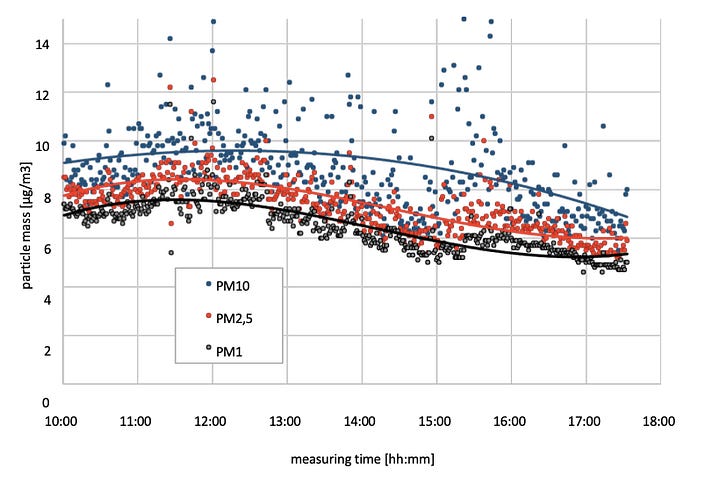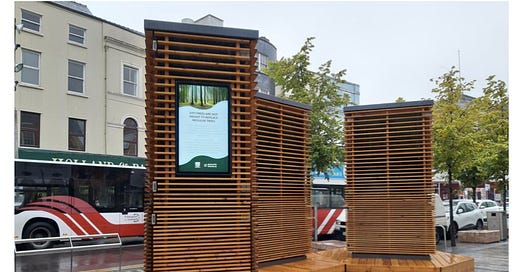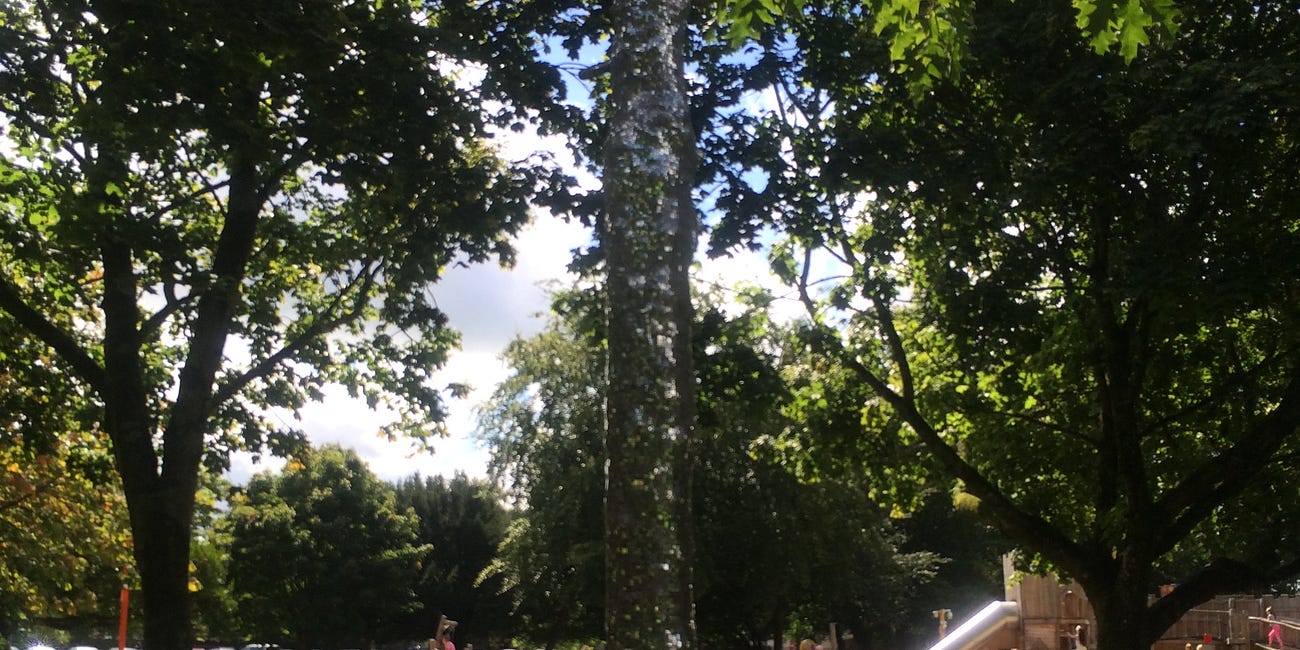Making sense of Cork City Council's 185-page 'robotrees' report
This week the City Council finally released their report into the €350k CityTrees installed during the pandemic. Tripe + Drisheen looks at the report.
Top line
The City Council concludes that more data is needed
The CityTrees won’t be unplugged
The “robotrees” cost €17,800 to keep operational
By now, everyone in Cork is familiar with the expensive Tardis-like moss covered wooden boxes placed in Cork City centre on Grand Parade and on St Patrick’s Street in August 2021 which are designed to clean the air, and also a place to park your backside.
This week, on November 7, the City Council presented a report to a meeting of the Environment, Water and Amenity Strategic Policy Committee. Essentially, it’s a report card from the City Council on the efficacy of the CityTrees which contains a review of the trees by Green City Solutions, the German tech company that makes the moss walls, as well as an independent review of the “robotrees” by a team at UCC and review of UCC’s review by Green City Solutions. Followed by a UCC review of Green City Solutions review of UCC’s review and rounded out by some next steps from the City Council. Are you still with me?
There’s a lot of padding and pictures in the initial part of the report, which might explain its “long-awaited” status. Officially, the report is called the Moss Wall Evaluation Report and the words robotrees are verboten.
Early on the in the report the scene is set. It’s post pandemic-ish and “quite understandably, a lot of fear among the public with regard to going back into crowded urban environments following long lockdown periods. Projects to be undertaken were to make urban environments attractive for everyone, to deliver environments that people felt safe in and create sustainable environments in Cities.”
It’s into this brave new world that an expensive experiment like the “robotrees” emerged as Cork City Council sought to “reimagine” the city scape.
“The Council was anxious that, as part of our response to reopening the City, we created more pleasant outdoor spaces for our residents, workers and visitors and ensured that the public felt welcome and safe in the City again.”
The padding continues and we are told that the CityTrees were part of €4m in funding that led to more pubic seating (the parklets), more bike lanes, more bike parking, pedestriantisation, waterproof outdoor dining and moss walls. (Absent in this list of more things are public toilets!)
If there is an overarching policy drive in the report that explains why the City Council bought into and bought the “robotrees” it’s to do with air quality. And back then, as we all knew only too well, a silent killer was making its way through the air infecting the world at large.
Now, the City Council never draws a line between the coronanvirus and the moss walls, but better air quality and all it brings with it is writ large in the report, and definitely in the minds of some of the senior, or the senior, exec at City Council, who sanctioned the trees.
Everything you wanted to know about Cork's new Robo-trees but were afraid to ask
The appearance of five high-tech moss walls known as CityTrees in Cork City Centre has stirred up a lot of debate, conversation and criticism during their installation this week. They’ll have their official unveiling on Thursday morning, when Lord Mayor Colm Kelleher will also launch Cork City Council's Air …
Reviews, and reviews of reviews
The reviews section of the Moss Wall report is both illuminating, dense and in the end both too much and not enough. The UCC team arrive at the conclusion that, “the CityTrees are unlikely to have a positive impact on air quality in outdoor settings which experience dynamic and continuous air exchange; they are more likely to be effective in areas of restricted air flow, such as enclosed or indoor spaces.”
Which is another way of saying, ‘plant’ them indoors. Bear in mind that UCC team were looking specifically to “assess the performance of the CityTrees in removing air pollutants”. They were “not investigating temperature or humidity or the weather conditions.”
Green City Solutions in their review of UCC’s review stood by their findings, but also took issue with the indoor sensor used by the university team in an outdoor setting.
“The manufacturer of these units states that the sensor used has a variance of +-10%. This variance in combination with the low concentration of PM2.5 measured, is already a potential source for the inconsistencies in the final measurement results.”
To wit, UCC come back and point out that they had a princely budget of €2,500 from Cork City Council for their review project, “while the results presented by Green City Solutions are from an 18-month EU funded research project with a budget of €1,815,000.” So not like for like. At all. Also, the UCC team point out that we could do with a lot more peer reviewed research of the CityTrees.
Which begs the question, why did the City Council not ask for more money for budgeting for independent reviews in the first place? They must have known that the “robotrees” were going to raise many questions, and the best place to get answers is via reviews and testing, but that takes time and money. €2,500 vs €1.8m. Do the math.
In the end, the City Council’s report agrees that more testing and studies are needed to get a more accurate picture of the the CityTrees.




Learnings, challenges and other cliches
In fairness to the authors of the City Council report, they don’t beat around the bush in their conclusions.
In the “Challenges” section the Council admits the data is inconclusive. There’s also the fact that the trees cost €17,800 in “ongoing annual maintenance” and there has “been negativity surrounding the units since their installation”.
But, as they also outline in the benefits section the CityTrees do provide seating, “raise awareness” and have the potential to “make available real-time air quality data to the public.”
As to what to do? Well the options are as follows:
Leave them in situ to grow and flourish. Move them elsewhere, to both indoor and outdoor settings. Engage in more research and scientific inquiry.
From there on in, the report goes into the appendix stage and the reviews by the scientists are presented in full.
In the end, it would taken a braver person at City Hall than the one who sanctioned them to turf them out, and so the “robotrees” will live on with us, and us with them.
Coming to a shopping centre near you?
And so, the robotrees are not for the chop - which I incorrectly forecast a few weeks ago - instead they will live on and find new homes, both indoors and outdoors and with it the business of scientific inquiry and report writing will continue.
If I was a betting man, I would say Mahon Point, which loudly and proudly and at every opportunity declares it green badge of honour, might get one of the “robotrees”.
And in place of the “robotrees”, perhaps we might see a real tree planted in the city centre and overtime we can all measure the joy and wonder it brings while also providing a home to the tiny multitudes.
Voices from Cork: Our favourite trees
A few years ago I interviewed a Qing Li, a Chinese doctor working in Japan who had just written a book about forest bathing. The premise of the book was simple enough. “I want to know why we feel so much better when we are in forests,” Li told me at the time. “What is th…








Thanks for the detailed report.
Was research done on the type of the particles?As far as I know moss and all damp biomass can harbor moulds which releases spores.These spores can make sick,think about Aspergillus and others.So were there cheap microbiological tests done, petri dishes up in the air?
We might have swapped soot for fungus ....